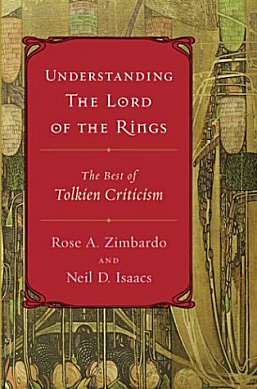Top Qs
Timeline
Chat
Perspective
Understanding The Lord of the Rings
Anthology of literary criticism of Tolkien From Wikipedia, the free encyclopedia
Remove ads
Understanding The Lord of the Rings is a collection of scholarly essays on J. R. R. Tolkien's Middle-earth writings, mainly concerning his fantasy novel The Lord of the Rings. It was edited by Rose Zimbardo and Neil D. Isaacs, and published in 2004. Apart from two new essays, it consisted of a selection of essays from two earlier collections by the same editors: their 1968 Tolkien and the Critics, and their 1981 Tolkien: New Critical Perspectives.
The collections have been welcomed by scholars, who have commented that the 1968 book in particular was "a milestone" in Tolkien scholarship. The 1981 book was described as a good overview of Tolkien scholarship, while the 2004 book was called a "splendid anthology". The Journal of Tolkien Research wrote that the 1968 and 2004 collections both had an importance "beyond doubt" in the history of Tolkien studies.
Remove ads
Context
J. R. R. Tolkien (1892–1973) was an English Roman Catholic writer, poet, philologist, and academic, best known as the author of the high fantasy works The Hobbit (1937) and The Lord of the Rings (1954–55).[1] In 1957, The Lord of the Rings was awarded the International Fantasy Award. The publication of the Ace Books and Ballantine paperbacks in the United States helped it to become immensely popular with a new generation in the 1960s.[2]
Remove ads
Publication history
Rose A. Zimbardo and Neil D. Isaacs have edited three related collections of scholarly essays on The Lord of the Rings:
- 1968: Tolkien and the Critics. Cover illustration by Rainey Bennett. University of Notre Dame Press, ISBN 978-0-268-00279-4.
- 1981: Tolkien: New Critical Perspectives. University Press of Kentucky, ISBN 978-0-813-11408-8.
- 2004: Understanding the Lord of the Rings, Houghton Mifflin, ISBN 978-0-618-42253-1. Jacket design by Martha Kennedy, using detail of Figures and Foliage by Charles Rennie Mackintosh
Remove ads
Contents
Summarize
Perspective
The three books, which are not illustrated, contain the following essays.
Remove ads
Reception
Summarize
Perspective
1968 collection

In Journal of Tolkien Research, Mariana Rios Maldonado wrote of the 1968 and 2004 compilations that "the importance of both collections to the history of Tolkien studies is beyond doubt".[3]
Richard C. West, in The J. R. R. Tolkien Encyclopedia, commented that "much of the best scholarly work being done during this period [the 1960s] was not in single books but in essays scattered in numerous journals. In his view, the 1968 Tolkien and the Critics "was a milestone that gathered some of the most significant such essays (those by Auden, Bradley, and Lewis, for example), and commissioned several new ones (notably by Mary Quella Kelly on Tolkien's poetry and John Tinkler on the use of Old English in The Lord of the Rings)."[4]
1981 collection
Reviewing the 1981 collection, M. Chassagnol wrote that the essays by McLellan and Adams took opposing sides on the merits of The Silmarillion. In his view, McLellan asserted "without really justifying it" that the work "demands comparison with Hesiod and The Iliad, Paradise Lost and Genesis", while on the other hand Adams, "more convincingly" saw nothing in it but "an empty and pompous bore".[5]
In Christianity and Literature, Janice G. Neuleib wrote that the volume must have been carefully prepared, as it covered a wide range of viewpoints incorporating "the best of earlier works" alongside new essays, forming "as good an overview of Tolkien scholarship as one can find".[6]
David M. Miller, reviewing the book in Modern Fiction Studies, calls Adams one of "the old guard", who "laments that The Silmarillion is not 'Son-of-Ring' and who wonders why people don't read the real stuff, rather than Tolkien's fakes." He respects Flieger and Kuznets for their essays which "make modest claims for clear theses and keep the text firmly in mind." He is less impressed by the essayists who assume or insist that The Lord of the Rings is Christian, giving as example Frodo's claiming of the One Ring at the Crack of Doom: "I will not do this deed. The Ring is mine!". Accordingly he objects to Zimbardo's psychological rewriting of the scene: "In fighting the Gollum in himself and subduing it, Frodo (i.e. Frodo/Gollum) is able at last to drop the Ring of Oneness - of falsely defined individuation - into the Crack of Doom". Broadly welcoming the book, Miller comments that Timothy O'Neill's Jungian The Individuated Hobbit should have been mentioned; and if "the Procrustean Christians are invited, Jane Nitzsche's Tolkien's Art should be called."[7]
2004 collection
Ron Ratliff, reviewing the 2004 collection for Library Journal, calls it a "splendid anthology". He comments that the dislike of figures like Edmund Wilson and Germaine Greer for The Lord of the Rings is well known, but that the "excellent essays" in its defence by C. S. Lewis and W. H. Auden are less familiar, and very welcome in the collection.[8]
Remove ads
References
Sources
Wikiwand - on
Seamless Wikipedia browsing. On steroids.
Remove ads

